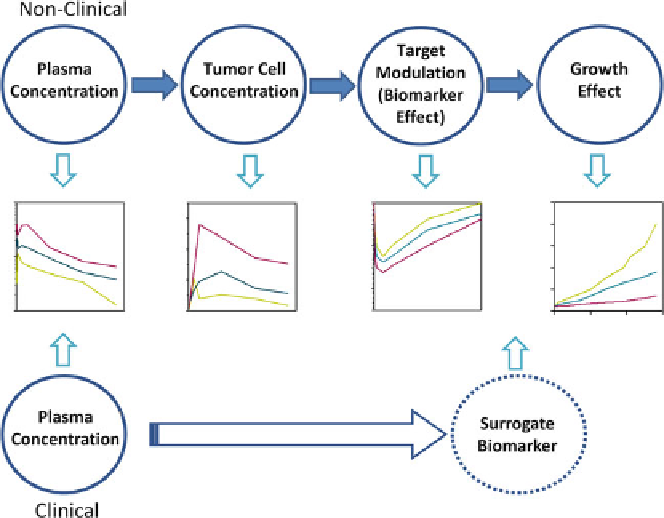Biomedical Engineering Reference
In-Depth Information
10000
100
80
60
40
20
0
150
100
1000
50
100
0
Time (hours)
Time (hours)
Time (hours)
Time (days)
Fig. 12.4
Diagram of nonclinical and clinical data obtained for pharmacokinetic-pharmacodynamic
studies. Nonclinical studies in oncology most frequently measure dose and tumor growth inhibitory
effects. However, by taking quantitative measurements and establishing mechanistic models to
describe the relationships between dose, plasma concentrations, tumor cell concentrations (i.e., site
of drug action), target modulation and resultant growth effect, we can better understand clinical
effects and may be able to more successfully translate and inform clinical decisions
the selection of patients with certain EGFR mutations predicted to confer sensitivity
to small molecule EGFR inhibitors, and in colorectal cancer, where patients with
wild-type
KRAS
may be eligible for Cetuximab therapy but not patients with mutant
forms of
KRAS
. Pharmacogenomic approaches have also been used in understanding
how polymorphisms in drug transporters and drug metabolizing enzymes affect
adverse outcomes [
60
]. Traditionally the understanding of inter-patient variability
has been studied by empiric population approaches. QSP approaches have the ability
to mechanistically understand how or which variables affect a given outcome. QSP
models can incorporate variability in targets, down-stream effectors, disease states,
as well as drug metabolizing enzymes and transporters (which can be identified by
various omics data) which can provide better prediction of the outcome or effect of a
compound in a population of patients rather than a single average. The inclusion of
semi-mechanistic to mechanistic pathway models and variability may provide
insight to genotypes or phenotypes predictive of response to therapy and may
even be useful in elucidating or predicting mechanisms of drug resistance.
The implementation of these preclinical and clinical modeling approaches may
help to reduce the risk of failure to translate clinically [
25
,
26
,
53
].

Search WWH ::

Custom Search